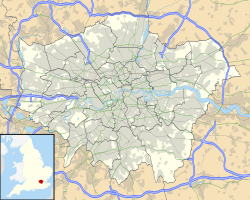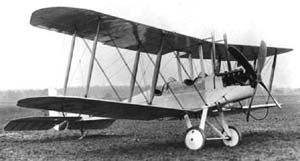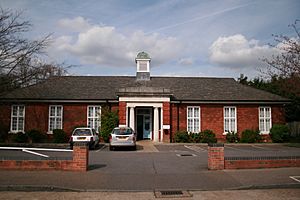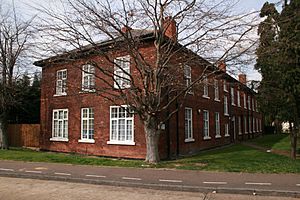RAF Hornchurch facts for kids
Quick facts for kids RAF Hornchurch
|
|||||||||||
|---|---|---|---|---|---|---|---|---|---|---|---|
| Hornchurch, Essex in England | |||||||||||
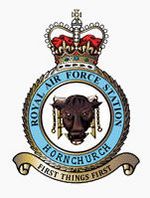
Station badge
|
|||||||||||
|
Shown within Greater London
|
|||||||||||
| Coordinates | 51°32′19″N 000°12′17″E / 51.53861°N 0.20472°E | ||||||||||
| Type | Royal Air Force station | ||||||||||
| Code | HO | ||||||||||
| Site information | |||||||||||
| Owner | Air Ministry | ||||||||||
| Operator | Royal Flying Corps Royal Air Force |
||||||||||
| Controlled by | RAF Fighter Command 1928-44 | ||||||||||
| Site history | |||||||||||
| Built | 1915 & 1928 | ||||||||||
| In use | 3 October 1915 – 31 December 1919, (As Sutton's Farm), 1 April 1928 – 1 July 1962, (As RAF Hornchurch) |
||||||||||
| Battles/wars | First World War European theatre of World War II Cold War |
||||||||||
| Airfield information | |||||||||||
| Elevation | 18 metres (59 ft) AMSL | ||||||||||
|
|||||||||||
Royal Air Force Hornchurch, or RAF Hornchurch, was a special air base in Hornchurch, England. It's now part of Greater London. This airfield was first known as Sutton's Farm during World War I. It covered about 90 acres of land.
Its main job was to protect London from air attacks. After the First World War, the airfield closed for a short time. But it was needed again in 1923 as the Royal Air Force grew. It reopened in 1928 as a much bigger fighter station. RAF Hornchurch was a very important base for many years, right up until the "jet age." It finally closed in 1962.
Contents
History of RAF Hornchurch
Protecting London in World War I
In 1915, a special defense area was set up around London. It was called the London Air Defence Area (LADA). Airfields were built to protect the capital from German airships, which were like big balloons. Sutton's Farm was chosen because it was in a good spot to guard the eastern side of London.
Sutton's Farm airfield started operating on October 3, 1915. It first had two BE2c aircraft. As more planes arrived, they were organized into 39 (Home Defence) Squadron in April 1916. This squadron was led by Major Thomas Higgins.
Over time, the threat changed from airships to enemy airplanes. So, better planes were brought in. These included the Sopwith Pup, Sopwith Camel, and Bristol Fighter. In September 1917, 39 Squadron moved, and 78 Squadron took its place.
First Victories in the Sky
The first time an enemy airship was spotted over Britain was on October 13, 1915. Lt. John Slessor from Sutton's Farm tried to attack it, but the airship disappeared into clouds.
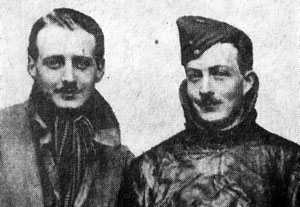
The first actual victory in Britain happened almost a year later, on September 2, 1916. It was thanks to a pilot from Sutton's Farm, Lt. William Leefe Robinson. He shot down a German airship called a Schütte-Lanz SL11. He used new special bullets that caught fire. For this brave act, Leefe Robinson received the Victoria Cross, which is a very high award. He became a national hero.
Two other pilots from Sutton's Farm, Lt. Frederick Sowrey and Lt. Wulstan Tempest, also earned the DSO for destroying enemy airships. Tempest's actions were amazing. Even with a broken fuel pump, he managed to fly his plane, pump fuel by hand, destroy an airship, and find his way home in thick fog. Many streets in South Hornchurch are named after these brave pilots.
Between the World Wars
After World War I ended, Sutton's Farm was no longer needed as an airfield. Most of its buildings were taken down, and the land went back to farming.
However, in the early 1920s, the Royal Air Force decided to grow bigger. They looked at old airfields to see if they could be used again. Sutton's Farm was in a perfect spot to defend London. So, the land was bought back, along with some extra areas.
It took four years to build the new airfield. It opened in April 1928 as RAF Sutton's Farm. Just two months later, its name was changed to RAF Hornchurch. The first group of planes to be based there was No. 111 Squadron, led by Squadron Leader Keith Park. He also became the first boss of the station.
RAF Hornchurch in World War II
During World War II, RAF Hornchurch was a very important base. It was part of RAF Fighter Command's 11 Group. This group protected London and southeast England during the Battle of Britain in 1940.
The command center for Hornchurch was in Romford. There was also a smaller, nearby base called RAF Rochford. Pilots from Hornchurch didn't like going to Rochford because they had to sleep in tents! Richard Hillary, a famous pilot and author, was shot down after taking off from Hornchurch on September 3, 1940.
After the war, Hornchurch was used for selecting new aircrew for 10 years. It also had a balloon unit for parachute training. On May 14, 1961, a soldier named Albert E. Small won the George Medal for bravery. He was helping with a parachute jump when the balloon started to deflate at 800 feet, but he stayed calm and helped.
RAF Hornchurch officially closed in July 1962.
What is RAF Hornchurch Today?
After the airfield closed, the land was used for digging up gravel and then filled with rubbish in the 1970s. Starting in 1980, the area was turned into Hornchurch Country Park. Most of the old buildings, including the plane hangars, were removed in the 1960s. This area is now a housing estate.
The streets in the housing estate are named after the airfield and its brave pilots. You can find names like Bouchier Walk, Tempest Way, Robinson Close, and Bader Way. The building where the officers used to eat and relax is now a medical center called Astra House.
A local school, The R. J. Mitchell School, is named after the man who designed the famous Spitfire plane. There's a big monument to him at the school. Another local school, Suttons School, was renamed Sanders Draper School in 1973. This was to honor an American pilot, Raimund Sanders Draper. He had an engine problem during takeoff but stayed with his plane to make sure it didn't crash into the school, which was full of children.
You can still see some old military defenses in the country park. These include pillboxes (small concrete bunkers), command bunkers, and gun positions. There are also many Tett Turrets, which are small, round concrete shelters.
A TV show called Two Men in a Trench even explored some of these defenses. They dug up a Tett Turret and found old RAF pilot's goggles from 1940!
The Good Intent pub, a local pub, was popular with the aircrews back then. It still has interesting photos of the station. Soon, an "RAF Hornchurch Heritage Centre" will open in Suttons House. This center will show artifacts and memories from RAF Hornchurch.
Images for kids
See also
- Battle of Britain
- List of Battle of Britain airfields
- List of Battle of Britain squadrons
- List of former Royal Air Force stations


